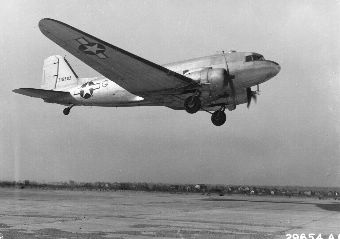![]() The Pacific War Online Encyclopedia
The Pacific War Online Encyclopedia
|
| Previous: C-46 Commando, U.S. Transport Aircraft | Table of Contents | Next: C-54 Skymaster, U.S. Transport Aircraft |

Douglas C-47A Skytrain
|
Crew |
2 or more |
|
Dimensions |
95’ x 64’5” x 16’11” 28.96m by 19.63m by 5.16m |
|
Wing area |
987 square feet 91.7 square meters |
|
Weight |
16,970-25,200 lbs (7700-11,430 kg) Absolute overload 33,000 lbs (15,000 kg) |
|
Maximum speed |
230 mph 370 km/h |
| Cruise speed | 185 mph 298 km/h |
|
Rate of climb |
20 feet per second 6.1 m/s |
|
Ceiling |
24,000 ft 7300 meters |
| 2 1200 hp (895 kW) Pratt & Whitney R-1830-90D Twin Wasp 14-cylinder two-row radial engines driving three bladed propellers | |
|
Range |
2125 miles at 170 mph 3420 km at 274 km/h |
| Fuel |
804 gallons 3043 liters |
| Capacity |
28 troops or 6000 lbs (2722 kg) cargo |
| 10,048 by 6/45 at Douglas Aircraft Company, Santa Monica, CA: 455 DC-3/DST 953 C-47 4931 C-47A 3241 C-47B 370 C-53 486 were produced by Nakajima as the L2D "Tabby" |
No combat aircraft, the C-47 was nonetheless a vital contributor to Allied victory in the war. It was the military version of the DC-3, capable of carrying 28 troops, or more in an emergency. It was used by virtually every combatant nation in the Pacific, including the Japanese, who had begun producing the DC-3 under a 1938 license before war broke out. However, the Japanese never seemed to recognize the full potential of military air transport. It was known in British service as the Dakota and was manufactured by the Russians as the Li-2. The U.S. Navy designated it the R4D.
The DC-3 was the third in a successful design
family and the prototype first flew on 17 December 1935. It was
originally designed for American Airlines, but many other airlines
placed orders, and about 500 had been produced by the time war broke
out in the Pacific. Production was promptly militarized and peaked at
4878 airframes in 1944. The military version featured a reinforced
floor and large cargo door. Civilian DC-3s pressed into military
service carried a bewildering array of designations: C-48, C-49, C-50,
C-51, C-52, C-68, and C-8. Those which retained their airliner interior
for the benefit of high-ranking staff were designated C-117. Postwar,
the DC-3 formed the backbone of the world's civilian air transport
industry, and some are still flying today.
About a third of all American C-47 aircrew
were deployed against Japan.
References
PilotFriend.com
(accessed 2010-8-5)
The Pacific War Online Encyclopedia © 2007-2011 by Kent G. Budge. Index